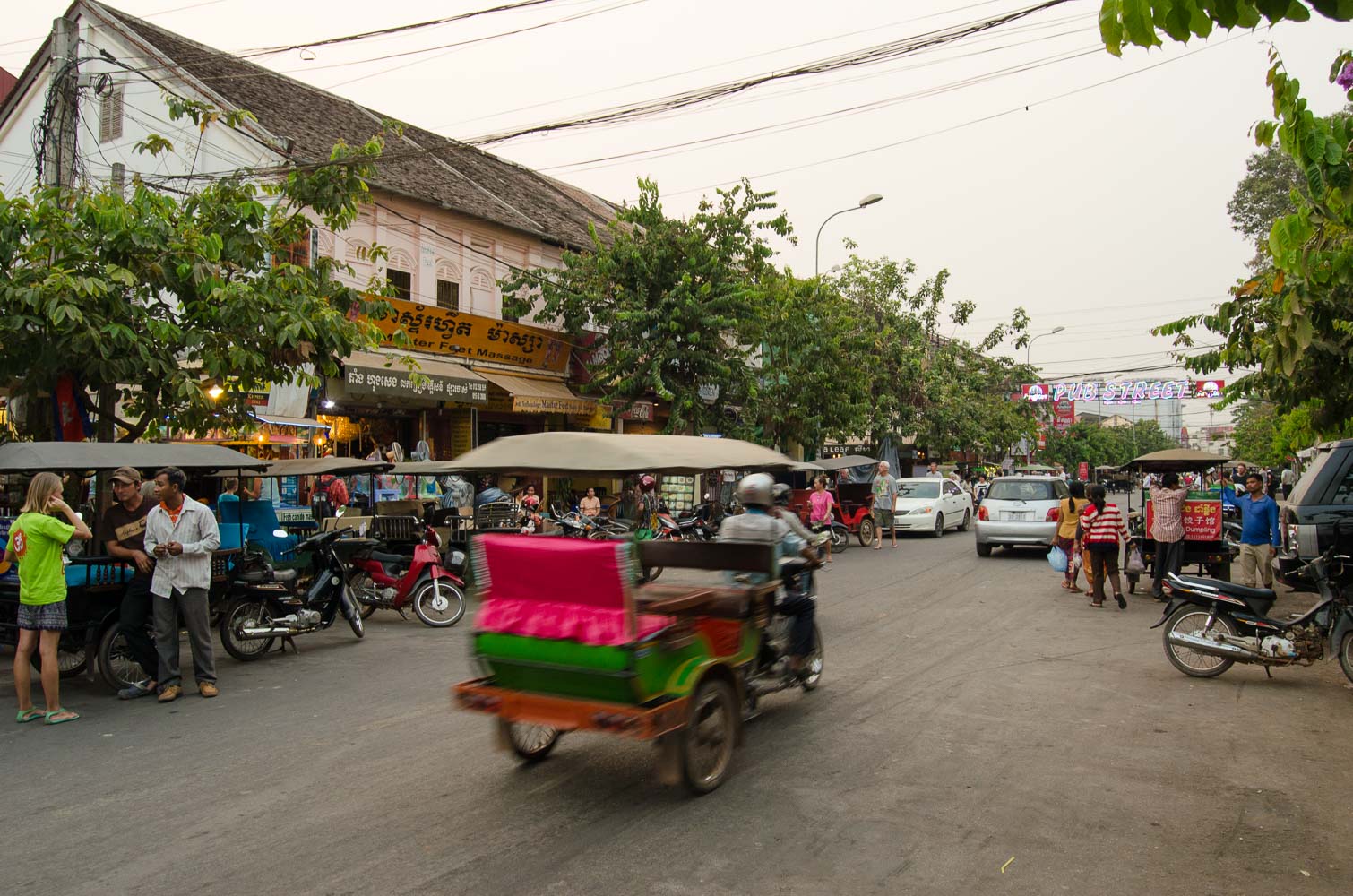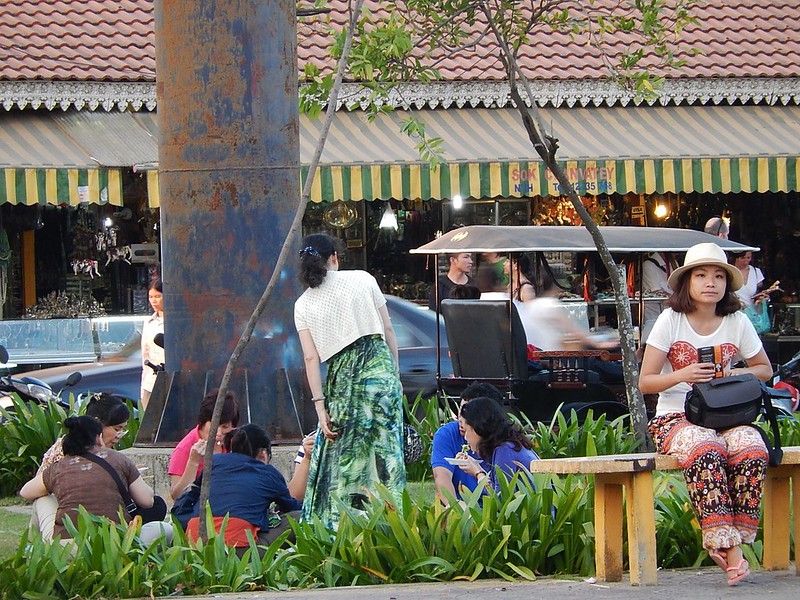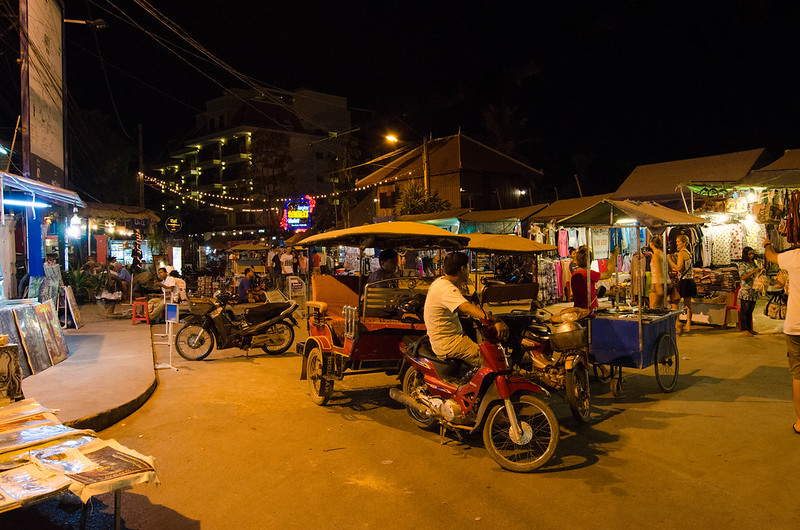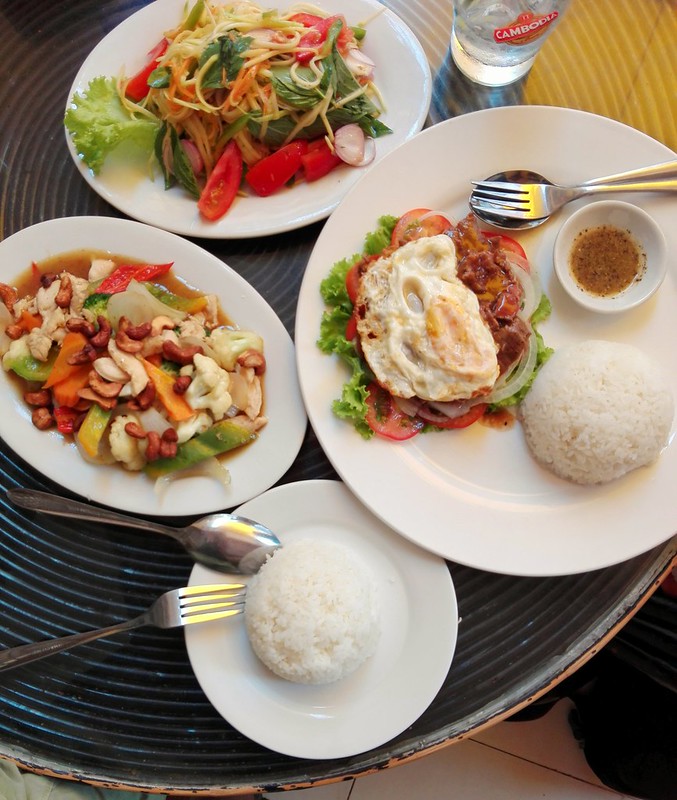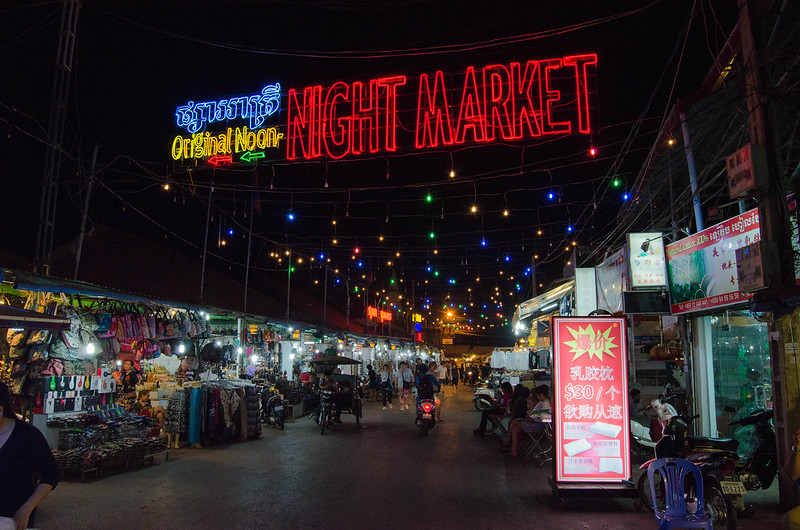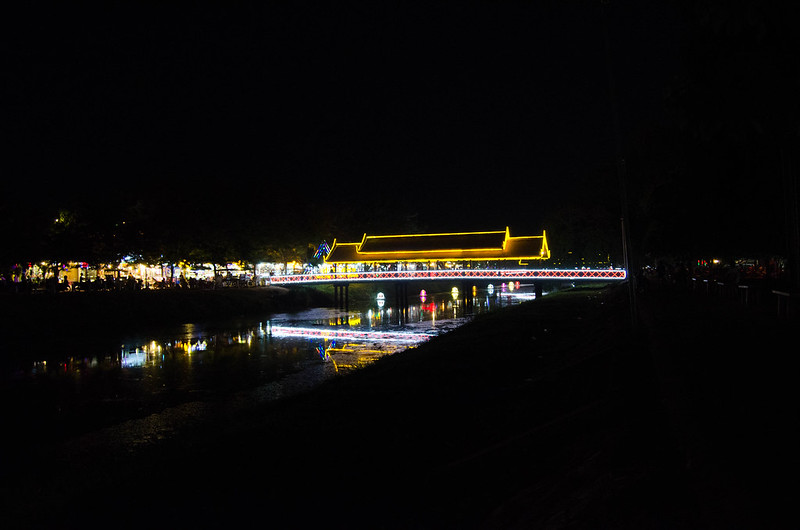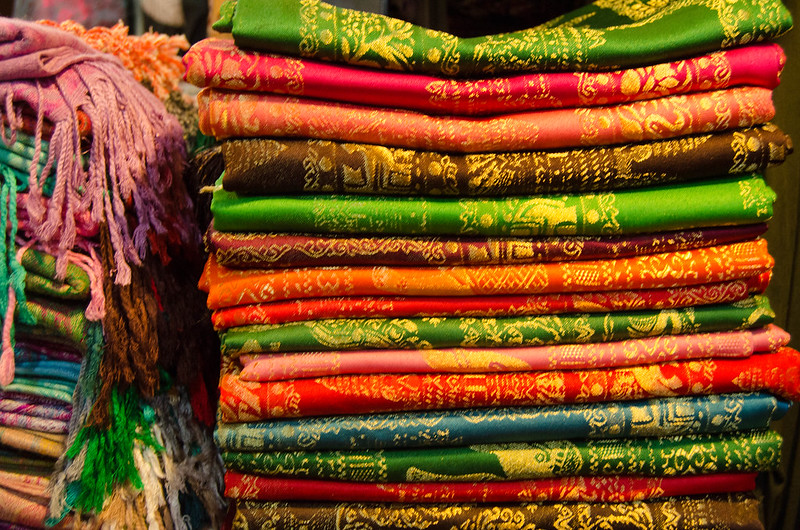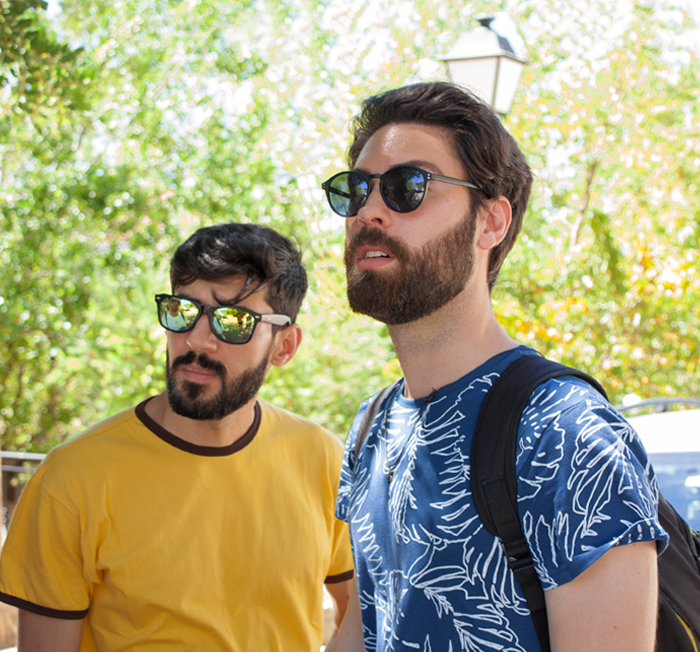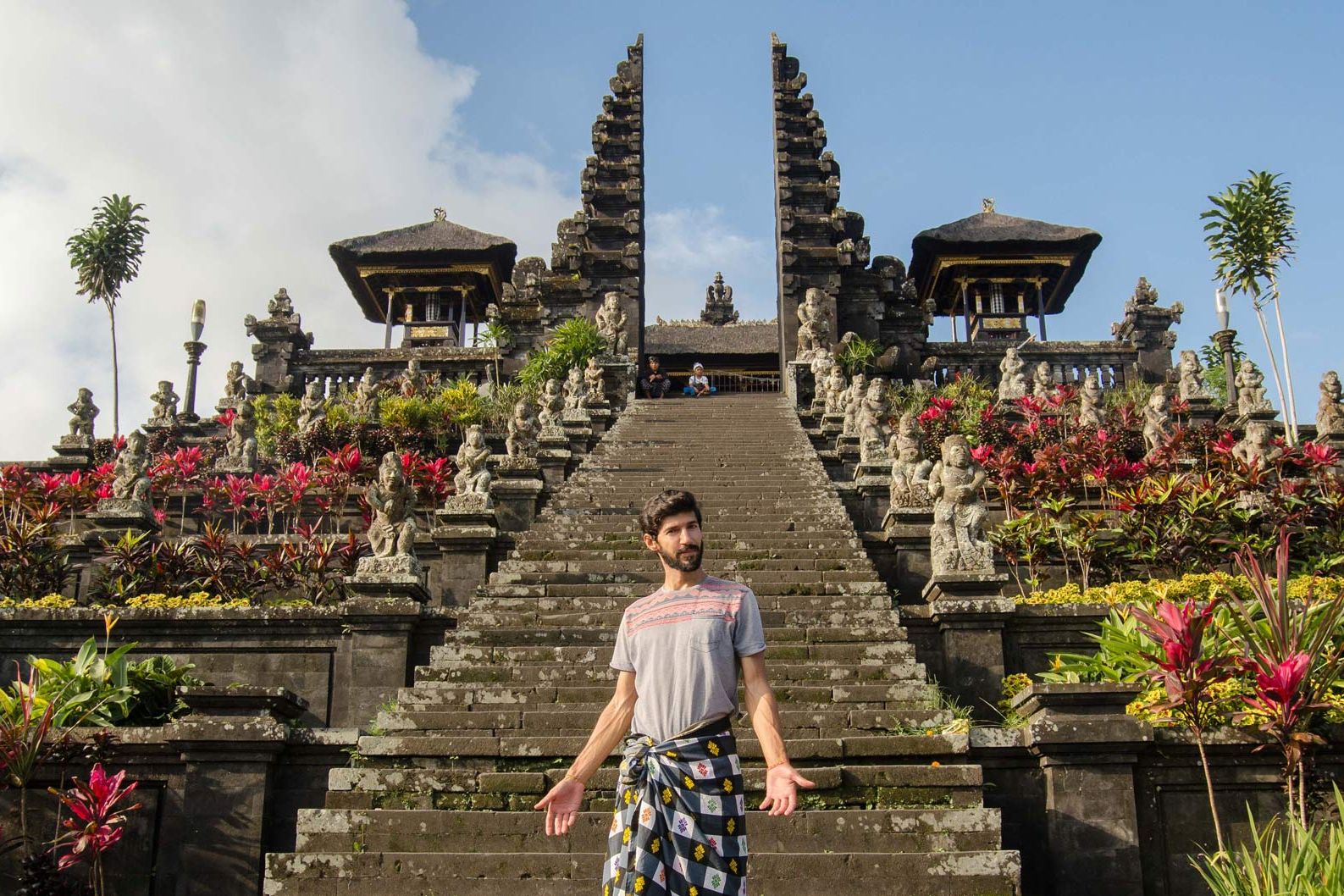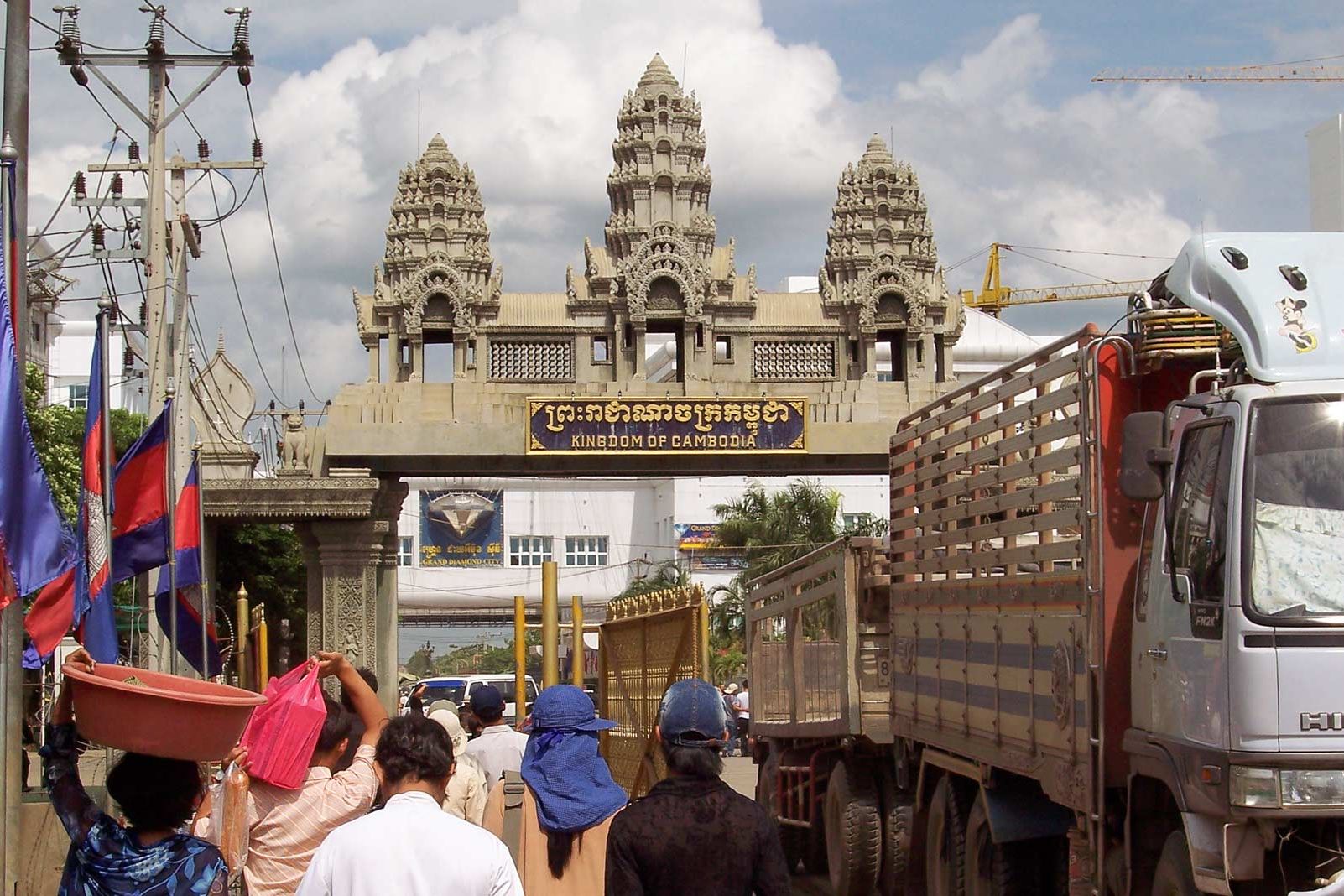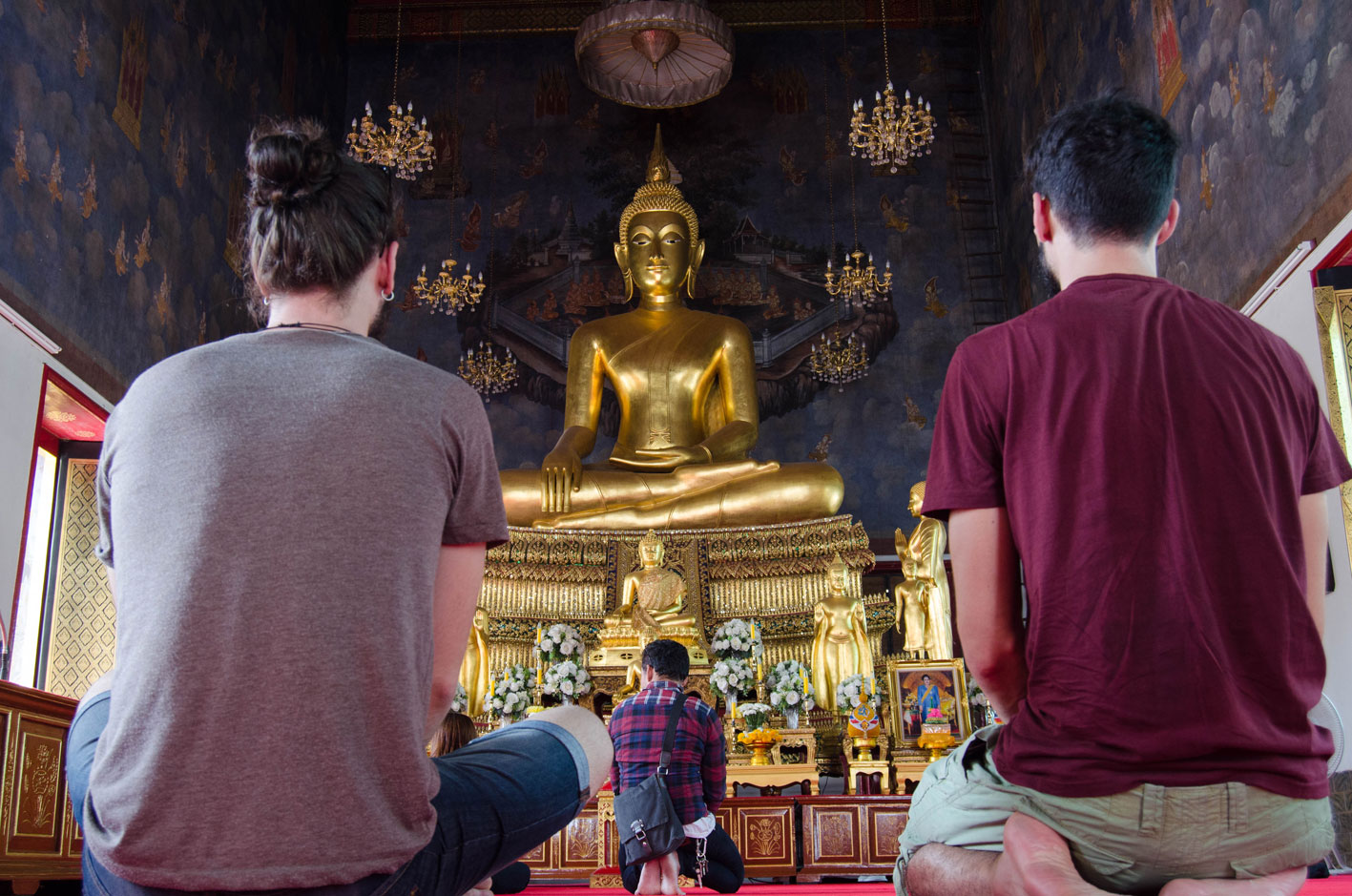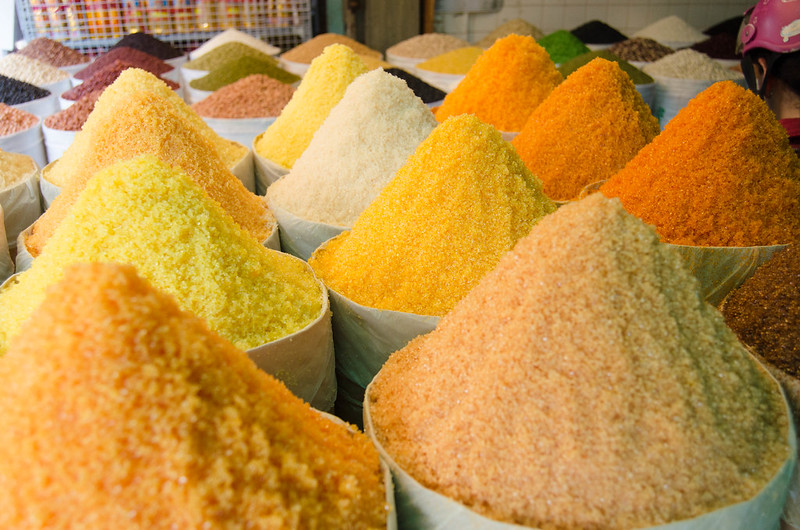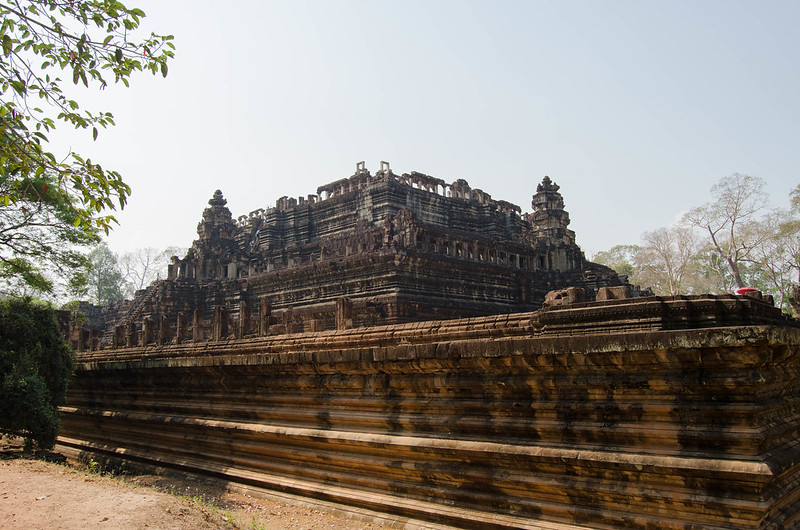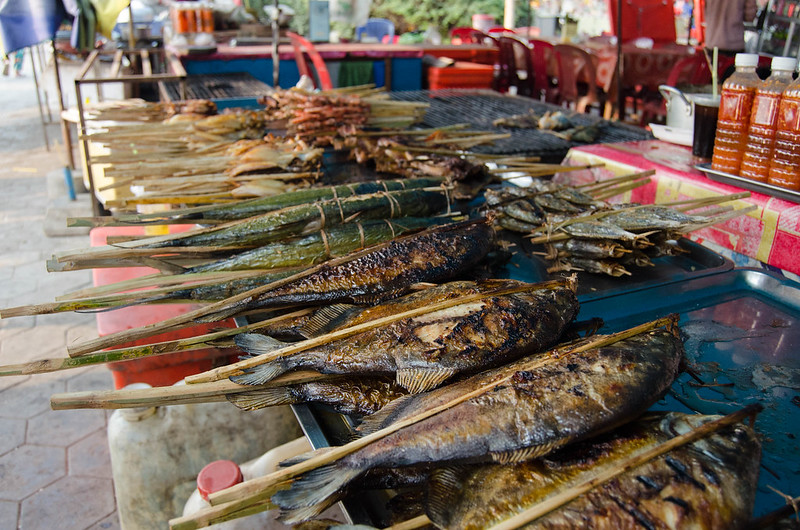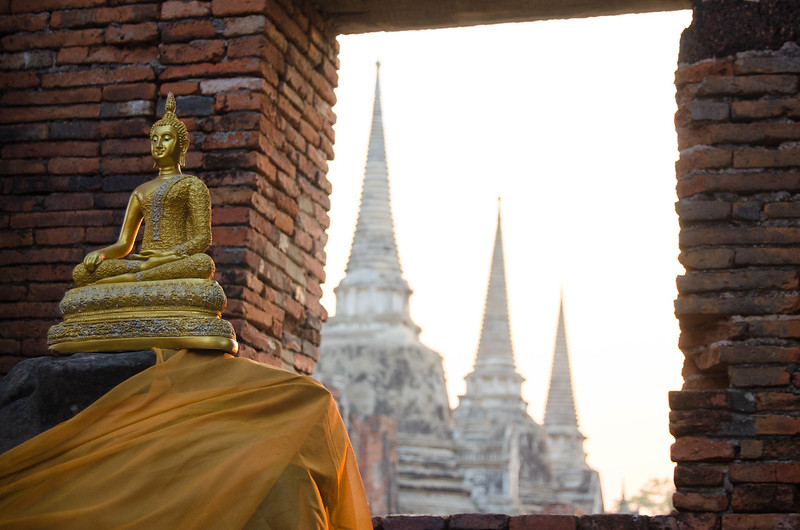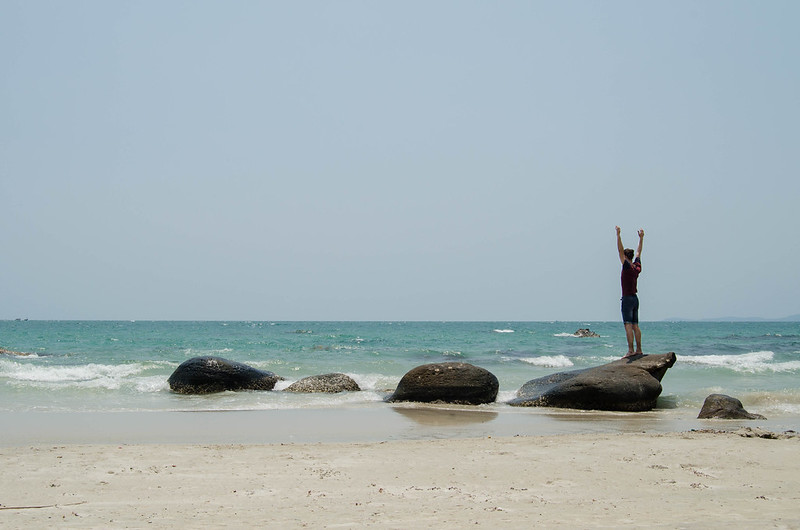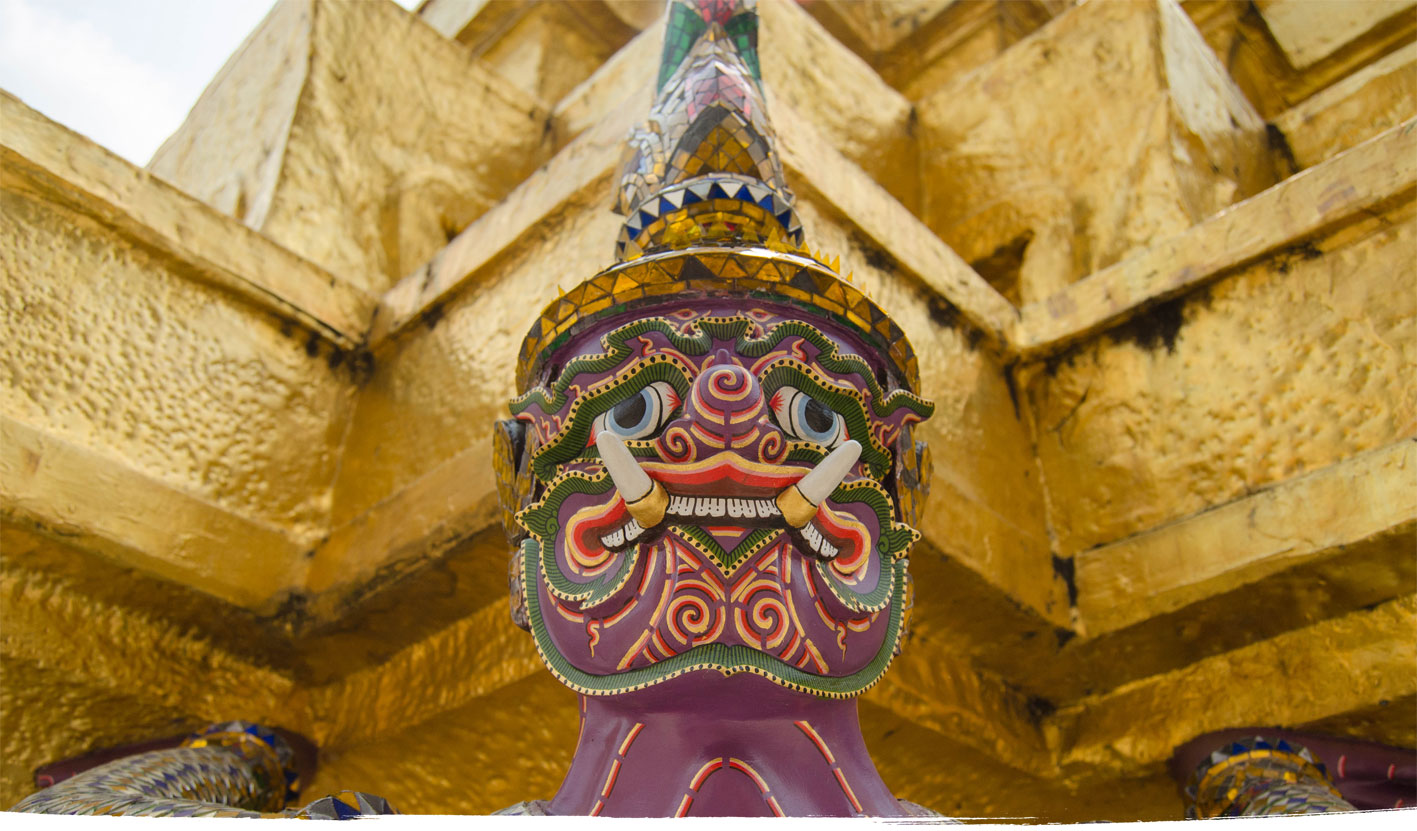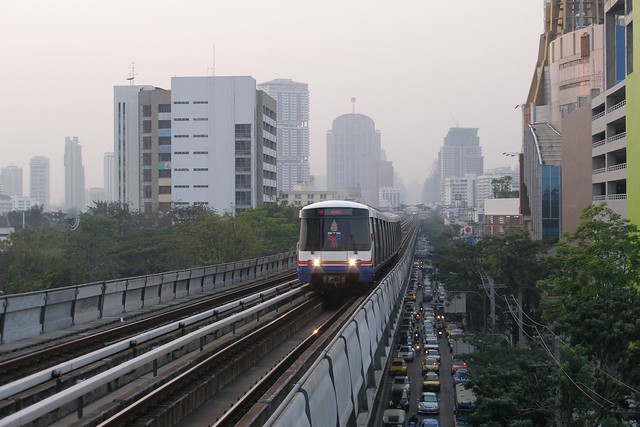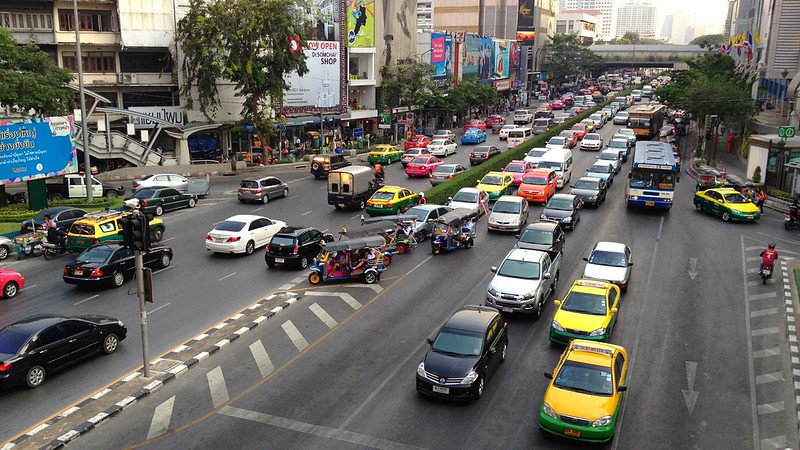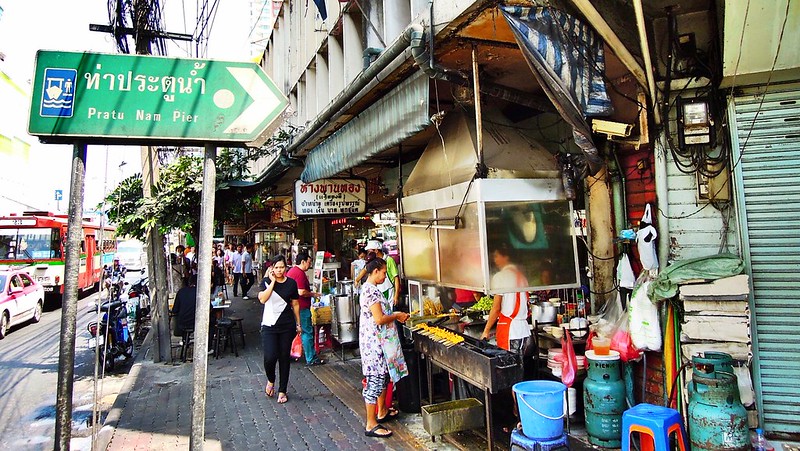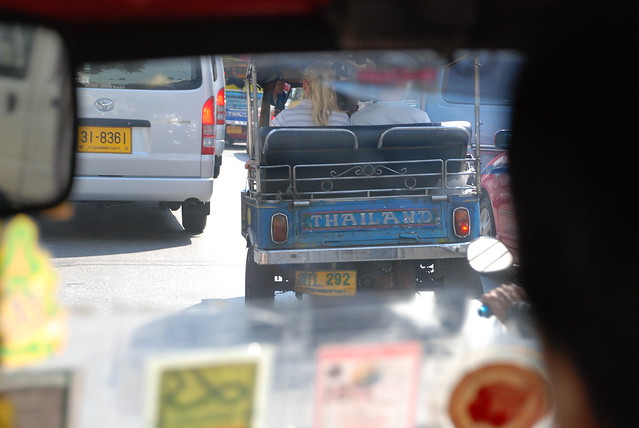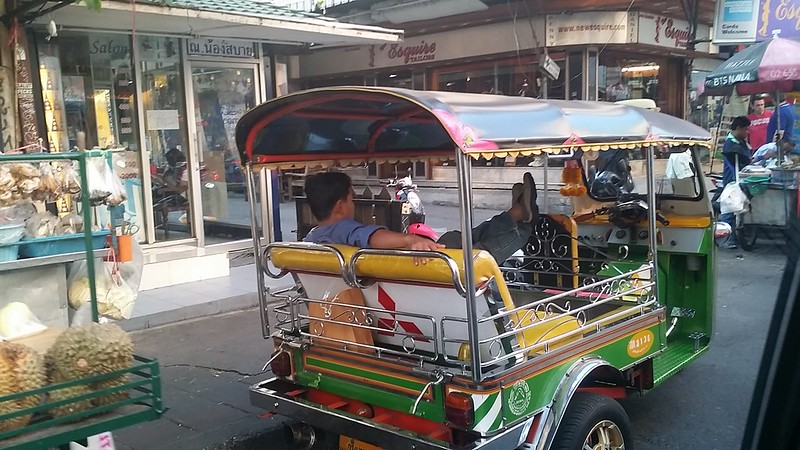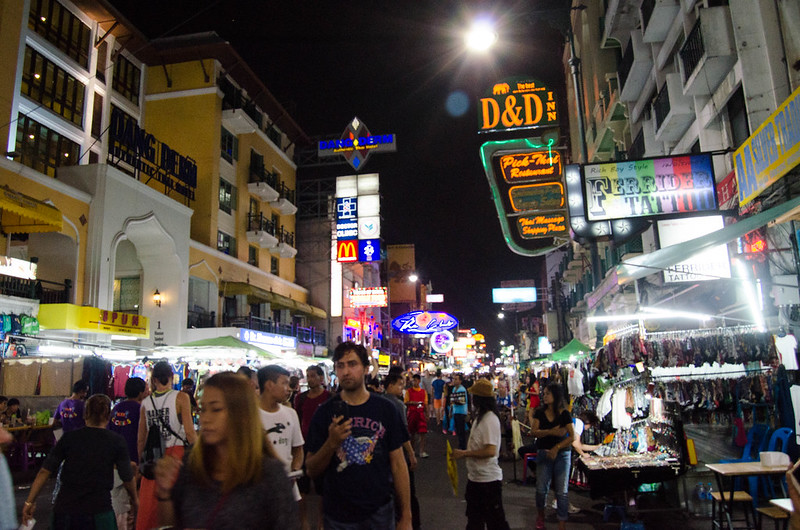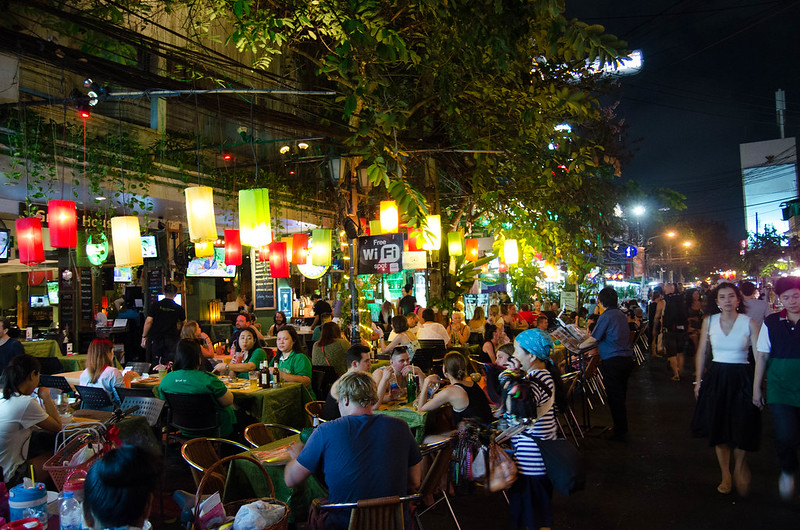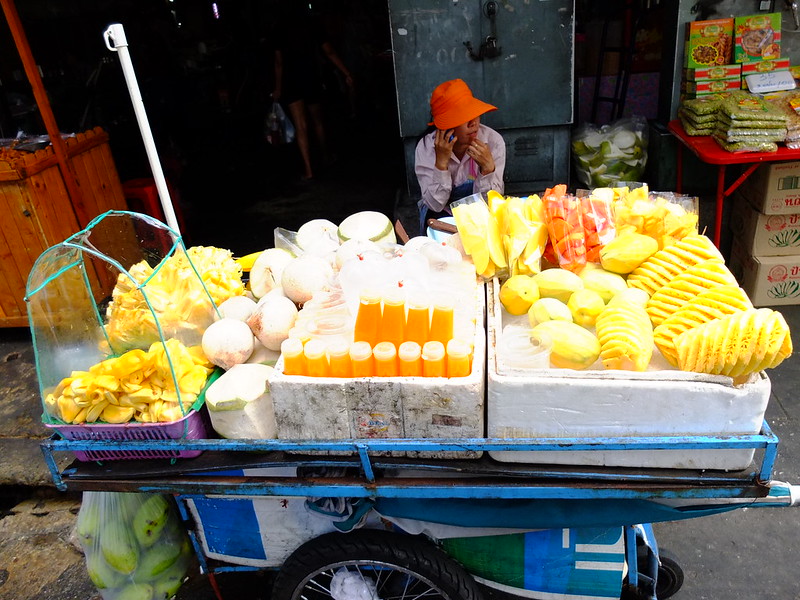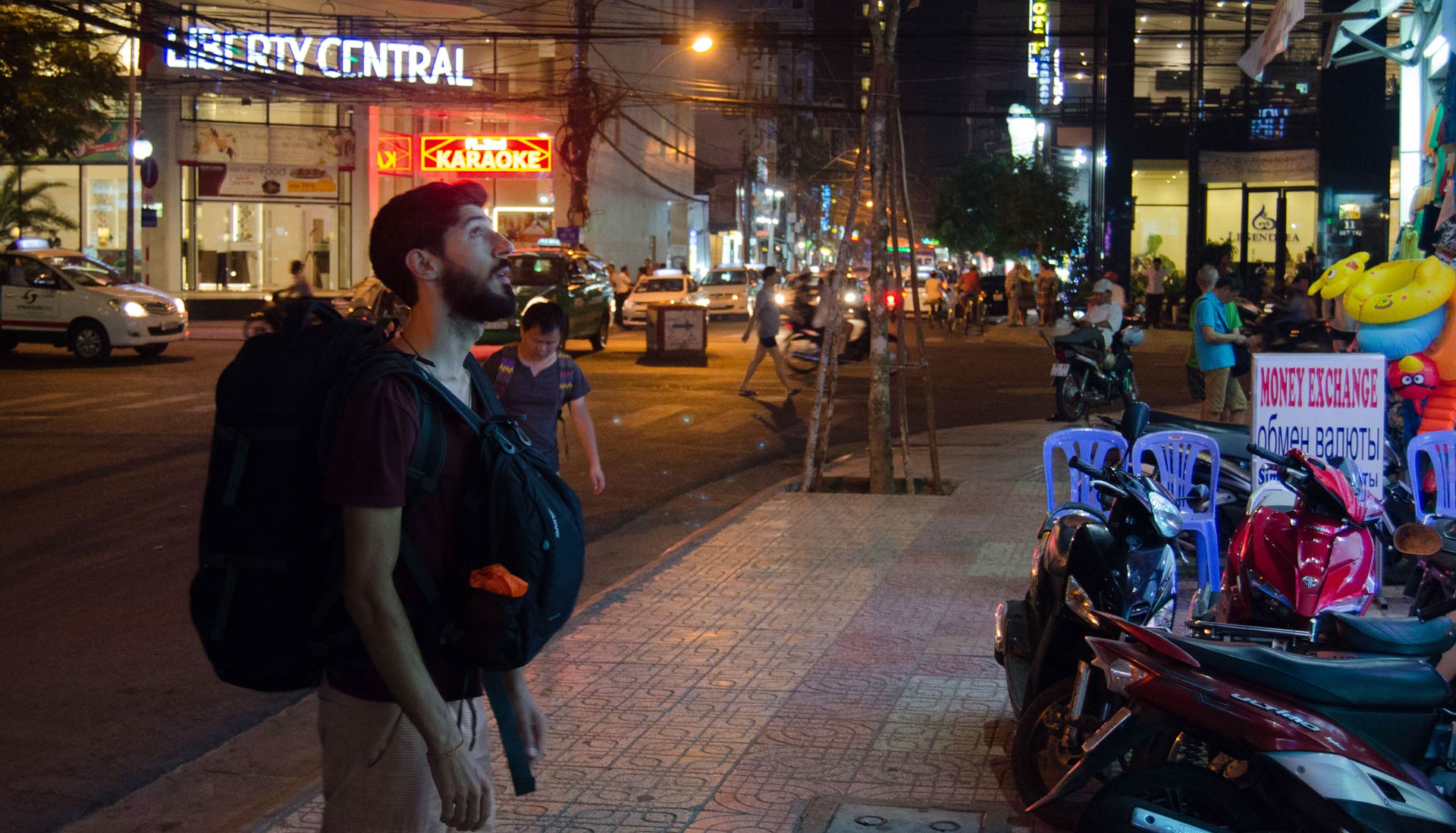Siem Reap for first-timers (What to Expect)
After the whole border situation entering Cambodia, we arrived in Siem Reap hesitant about the days to come. You can read the whole story here → Crossing the Infamous Poipet Border in Cambodia.
Siem Reap is a “small city” that rapidly grew and adapted to the massive tourist influx at the expense of the Angkor Temples. A river also called ‘Siem Reap’ divides the city in two. In the Royal Gardens, you can rest and escape from the afternoon heat under the old trees. Here’s where locals come to relax on the benches, socialize and play jianzi.
The sunlight has a magical deep orange hue and the city seems to be calmer around this area. There aren’t many people in sight, only a few local passerbyers, and businesses seem to be slow as most tourists are hiding from the heat or visiting the Angkor temples.
At the beginning and end of each day, an amusing anarchy in traffic starts. Cars, tuk-tuks, and minibusses packed with tourists come and go to the temples. Scooters and bicycles run wherever as fast as they can. Sidewalks are parking spots and pedestrians are forced to walk on the road — it’s every man for themselves.
Breathe in, breathe out
In Siem Reap, tuk-tuk drivers are next-level annoying. All they want is to take you on a tour of the temples or sell you some cocaine — both preferably. They’ll be parked on random streets, and outside every restaurant, hotel, and coffee shop waiting for tourists.
At the moment they see you asking for the bill in a restaurant, they’ll start touting. They will shout, whistle, clap, and hiss to get your attention. It’s intense. Breathe in, say ‘thank you’ and keep moving.
Tasting the gravy
Khmer food is amazing, and Cambodians are like wizards of pepper: amouk is great, Lok Lak even better. The spicy mango salads and the pork with pineapple are to die for.
Try all of the above with a fruit smoothie, any fruit smoothie.
We had the majority of our meals in a great restaurant called Moul Chheng Heang, near our hostel. The food was delicious and so were the prices, but what made us return every night, was the lovely enthusiastic lady running the restaurant.
She finished every sentence with:
– Yeah, yeah!
And lovingly made us promise we’ll return the next day.
– See you tomorrow. Ok?!
– Ok.
– Yeah, yeah!
Tip: The average street food costs 2,5USD. In restaurants near Pub Street meals start at 7 or 12USD. In most supermarkets, water is more expensive than in restaurants.
A dolla’ makes them holla’!
It’s weird to see an entire country on the other side of the world running on dollar bills.
Throughout Cambodia, you’ll need US dollars for everything: food, hotels, entrance fees, and transportation. They don’t care for their currency, so if you try to pay anything in Rhiels, they’ll roll their eyes at you.
Oh! And you better keep the dollar bills in pristine condition or they won’t take them.
The problem with the dollar bills is that everything got more expensive. There aren’t any nuances in prices and everything got rounded up to 1USD, 5USD, or 10USD.
Banks will give you dollar bills by default when you use any ATM, and the average fee is 4USD for each withdrawal.
A tip for European travelers: even though there’s a money-saving tip on Lonely Planet about Canadia Bank not charging any fees, it doesn’t work for European debit or credit cards.
Pub Street at night
Everyone comes here when the sun goes down: locals, backpackers, and tourists of all ages come to eat, drink and shop around. The street is filled with restaurants, massage parlors, coffee shops, and bars. And there’s always a happy hour somewhere.
Color is everywhere: in the neon lights of the bars, the tropical fruit in smoothie carts, the brightly lit bridges, and in the night markets on both sides of the river — Old market, Angkor market, and Night market.
Interacting with locals in Siem Reap
Unfortunately, every conversation that occurred was intended to make a sale and was definitely not in our best interest. As tourists, we got singled out and only treated as such. Locals couldn’t care less about your presence, so conversations never happened.
Siem Reap travel expenses (daily average for 1 person)
Water: 0.28€
Accommodation: 14.20€
Bicycle: 2.66€
Meals: 3,10€
Laundry: 0.87€ per kilo
If you have any questions or some extra info to share, please leave a reply. Thank you!
The first month of traveling
So one month has passed and we’re currently in Vietnam writing our first thoughts about a whole month of travel.
We’ve been able to visit a bunch of different cities and countries which means: being constantly stimulated by everything those new places have to offer. Plus, the daunting notion of everything we planned to do in this trip, keeps burning in the back of our minds.
Long-term traveling requires a different mindset than the one we’re used to.
Unintentionally, we got caught in a rhythm like we were trying to fit everything on a 10-day vacation. Every day was filled 100% with as many activities as possible and all that was doing was stealing our presence and making us neglect our bodies. Not to mention that it was completely unfair to the places we were visiting. We needed to slow down.
Let us illustrate what might happen if you don’t slow down:
When you’re feeling physically exhausted but decide to keep going anyways for two more hours before having a rest, is when that new local market you’re in seems like every other you’ve seen so far.
When you decide to cram every Angkor temple in the same day even though there’s like 40ºC in the sun and you’re doing it by bicycle, is when you get ‘templed out’, dehydrated and over it.
When you decide to check those 20 iconic sites before breakfast, the fun experience of trying a new dish at that quirky local restaurant with not an English word in the menu is replaced by a BigMac at the first McDonalds you find “because you’re starting to feel woozy from the low blood sugar”.
When you’re drained, that characteristic street from Asia filled with thousands of motorbikes, honking cars, and busy locals will just annoy you and make you want to run to your hotel room. And when you get there, the irrelevant slow Wi-Fi connection can make you GO BONKERS!
The most obvious piece of advice you’ll ever hear
It’s important to know your body and your limits to begin with. No matter what part of the world you are, you’ll still need plenty of water, good food, and rest. BOOM. You’re welcome.
On another note
This whole experience has been quite positive and quite doable.
Crossing borders, new people, the amazing sunsets and white sand beaches, the swollen lips from too much chili, the days that blend together and feel like a giant Saturday, the unmeasurable freedom
We’re learning to relax more and enjoy each place we’re in. We’ve started to slow down, creating time to appreciate where we are and to be grateful for the privilege to be there.
The time we have in our hands actually allows for less structured days and the outcome is openness. Openness to change plans and make new ones as we go. To appreciate little things like the vibrancy of the flowers, the sweetness of the fruit and the smiles of locals passing by. Not only the breathtaking postcard-worthy scenery. It even grants the distance to look at the lives we have back home. Perspective.
We’re waking up feeling less tired and more inspired.
Long-term traveling is good and we definitely want more of it.
The sad smiles of Bangkok
After an eleven hour trip, we arrived at Bangkok’s Suvarnabhumi International Airport at 7:30 am and a scalding breeze welcomed us as we left the plane.
Nuno was afraid that they wouldn’t let us pass through the immigration port because we didn’t have a return flight. The process ended up being quite simple, some minutes in the queue, a smile from us, a photo and two stamps from them.
We were officially in Thailand! Kob khun krap!
Hopped on a train to the city center for 45THB in a 25min ride. The train is above ground which allowed us to see the city from afar. First the neighborhoods with terraced houses, separated by greens lakes, waterways and banana trees. Here and there the golden roofs of temples peaked from between the trees. As the city got closer, the train got fuller with quiet locals absorbed by their cell phones and sniffing on Vapex inhalers.
We left the train at the last stop (Phaya Thai) and started to feel the real city: traffic noises, new smells, thousands of locals in every direction and the unforgivable heat. We barely started walking and we were already sweating profusely. We got to Bangkok on a flight from Stockholm, so we were still wearing semi-winter clothes.
After some minutes walking, we entered the first building that seemed to have air-con. It was a mall filled with teenagers and a nice food court, an opportunity to freshen up and grab something to eat. We ate Tom Yum Noodle Soup.
With a full stomach, the journey to the hostel started. It was quite an adventure under the scalding sun.
We walked and walked, turning and rolling the map* on itself, asking the locals for help, but getting back a smile and Thai gibberish that didn’t help at all. Every kilometer made the bags feel heavier.
*You can get the city map on the airport at the Tourism Authority of Thailand for free.
As soon as we found the right street a Thai guy approached us asking where we came from, how many days we’ll spend in Bangkok, and to where we were heading. He told us that being a Friday, some monuments were totally free and the tuk-tuks with the yellow license plates were cheaper and would gladly take us there.
He also insisted a hundred times that we should go see the Big Standing Buddha.
We just want to get to our hostel man. Not now.
So here’s the deal: if you go to Bangkok you will get approached by tuk-tuks non-stop.
And if not by tuk-tuks, by guys working on commission for them, or for a store that makes money selling overpriced crap to tourist. Be prepared.
To them, anything works as an icebreaker:
– Hey ma’ friend. Where are you from?
– When did you arrived in Thailand?
– Nice beard. How long did it take to get it like that?
– Where are you going?
– When are you leaving Thailand?
– I’m a University teacher and I’m not trying to sell you anything, but…
– Need help ma’friend?
Days later a tuk-tuk guy, after we refused his ride, actually lied to us saying the temple we were considering visiting was closed that day. After insisting on trying anyways, he sent us in the wrong direction, following us until we got completely lost, trying then to make the sell. Not cool man, not cool.
And the funny part was that in the end, he just wanted to take us to the Big Standing Buddha.
All of this persecution will make you feel like a Big Dumb Standing Tourist.
Bangkok is a worn down, full of life, hectic city.
A reflection of that is the famous Kao San Road, a place for the ones who like to party. Neon lights, hundreds of tourists, street shops, vodka buckets and loud music from the bars constantly competing with each other.
Parallel to Kao San is the mellow and bohemian Rambuttri Road. Good music, plenty of street food, fruit sellers, cool restaurants, nice bars, lighted trees, and plenty of Thai massage spots. It’s a great place to have dinner and spend your evening.
Definitely worth a visit.
Thailand is renowned for it’s cheap and delicious street food. It’s everywhere at any time of day. You can have a delicious pad thai from 50 to 80 THB.
There are plenty of iced sliced fruit to eat for 20 THB. Sweet mango, papaya, dragon fruit, watermelon and pineapples, all peeled off and sliced, laying in huge amounts of crushed ice.
You should also try the egg and banana pancakes, the coconut water, and all the fruit juices at hand.
You’ll also feel the need to drink insane amounts of water. We went to Thailand in March and the heat was intense! Fortunately, water was everywhere, you can buy them at any 7 Eleven scattered all over Bangkok. A big water is only 13THB, the same price we buy them in Portugal, plus, you can buy them cold. It’s also a good excuse to break your 500 or 1000THB bills.
Talking about money, there are ATM machines available everywhere, so no need to worry. But they’ll all charge you a 200THB fee for every withdrawal. To that, don’t forget to add your own bank’s fee.
I believe we’ve all heard about the famous Thai sympathy. Locals do have a constant gentle smile on their faces, especially to foreigners, but they’re also quite reserved. This narrowed our interactions to vendors and merchants, and according to our experience, they’ll drop the smile as soon as you drop the money.
Maybe you’ll get a robotic ‘Bye’ at the end.
But maybe that’s just in Bangkok.
By the way, we ended up finding the Big Standing Buddha by ourselves.
Couldn’t understand what was the fuss all about.
Bangkok travel expenses (daily average for 1 person)
Meals: 1,96€
Water: 0,27€
Hotel: 5,50€ (Private double room)
Subway from Suvarnabhumi Airport to city center: 1,00€
Tuk-tuk to Chatuchak market: 2,60€
Site’s entrance fees: 6,39€
If you have any questions or some extra info everybody can benefit from, please leave it down in the comments! We’d love to hear from you.
The winning Backpack
The main item for any backpacker is a proper backpack.
Also essential, is the realization that you’ll need to travel with the least amount of things possible. Fewer things mean less weight on your back, more mobility and comfort. As two practical guys, we decided that one big backpack will be enough for the both of us.
The process of choosing the ideal backpack started by analyzing the needs and challenges we could encounter while traveling.
Requirements for the perfect backpack:
• Easy access to the whole interior;
• Flight cover or removable straps for an easy airport check-in;
• A capacity of 70 to 80 liters;
• A small detachable daypack;
• Easily adjustable straps considering it will be carried by two different people;
• Comfortable padded shoulder straps;
• Rain cover;
• Approximate cost: €150
The Brands
We headed to Google and started the search.
The main brands are, Haglöfs, Deuter, Eagle Creek, Osprey, Patagonia, Monte Campo, Rei, Kelty, Jansport, Lowe Alpine, Tangoworld, Mammut, Karrimor, Caribee and The North Face.
Nuno was responsible for listing them all. He spent several days looking for backpacks and as a conscious consumer, arranging all the information on Excel (yeah, he’s that kind of guy).
The three finalists were: *Drum rolls*
• Vango Freedom 60+20,
• Deuter Traveler 60+10,
• Osprey Farpoint 55 (40+15).
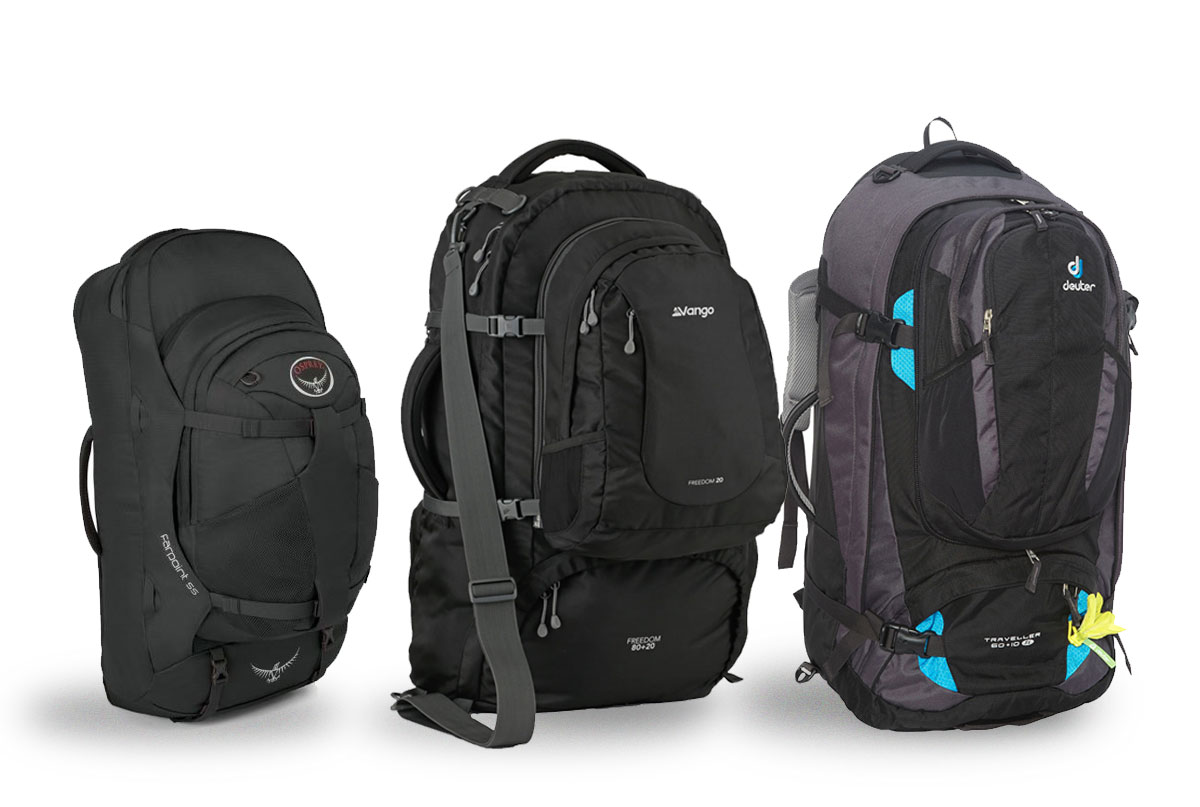
The winner backpack
We decided to buy the Vango Freedom 60+20.
The only downside to this backpack was that the rain cover wasn’t included, so we had to buy it separately for an extra €15.
The purchase
Vango has an online store but they don’t ship to Portugal.
Luckily we found the website Noite de Campo http://www.noitedecampo.com that sold Vango backpacks in Portugal, but the model we wanted. We contacted the store anyways and asked if they could get the Vango Freedom, and they actually did! A month later the backpack arrived with no delivery charge.
The backpack ended up as a birthday gift to Nuno from all of his friends.
Check the video for more details
If you have any questions about the Vango Freedom 60+20, please leave it in the comments below. Thanks for stopping by!
